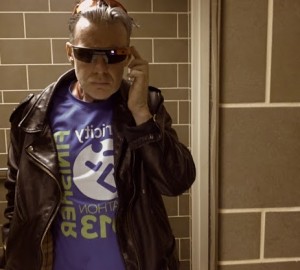Starting 2014 off with a bang, one of our biggest IT Rockstar Interviews yet.
Dealing with an ongoing joke that enterprises think UX (User Experience) is a dirty and expensive word.
But in today’s movement of Consumerization of IT, there is no more option of bad design and cluttered apps as employees will drift out of the internal app markets looking for non-approved solutions.
So we rounded up:
Ultan O’Broin (@usableapps), Director, Oracle Applications User Experience, has worked in Oracle E-Business Suite and Oracle Cloud Applications development in the U.S. and EMEA since 1996. Before that he was a localization manager with Microsoft. A passionate evangelist for applications user experience, he communicates proven enterprise usability best practices to the Oracle applications development community, customers, and partners worldwide. Globally, if he could end the curse of crapplications in enterprises everywhere, he’d retire happy. Learn more at Oracle’s Usable Apps Blog and Usable Apps Website.

Cassie McDaniel (@cassiemc), Lead UX (User Experience) and UI (User Interface) designer at Mozilla’s Webmaker
Cassie has a long track record of innovative designs, as you can see first hand on her blog. For her latest work and more info on Mozilla’s WebMaker check out their site here.
1) If a non-designer tech person sits down, clean slate, to make an enterprise app – what is the first piece of advice you would give them?
[Ultan] First, find a real end user. Not the IT Department if it’s a back office application you’re developing and not the Marketing Department if it’s a public-facing website. Those groups are valid stakeholders but probably not real end users. A real user doing real tasks in a real environment is the essence of what user experience is about. Find out users’ goals, tasks, expertise, their pain points, and their expertise. Watch them as they use tools and ask, “tell me more about that”. Understanding context of use is critical so understand users’ working environments, what tools they use and why, and who they interact with. Then, start coming up with solutions. Keep users at the center of the process and iterate designs, prototypes with them and testing with them on the final app too.
[Cassie] Ask a lot of questions. This, I believe, is the designer’s most important task – otherwise they are just stylists. Asking the right questions and digging deep into users’ motivations and behaviors will let you create something that is both desirable to use and truly different from your competitors. Don’t underestimate feedback from anyone as great ideas can come from anywhere; the best designers are always doing something new and uncharted, so they are never fully experts, but they have usually mastered the art of listening.
2) Doing mobile chats I have seen two conflicting cases on enterprise app UI.
One person said he hates stripped down mobile apps that don’t have the full features of the website. Someone else said they hate apps with too many features. Any thoughts on how an enterprise can make everyone happy?
[Ultan] One size doesn’t fit all, but you can be smart about how you design optimized UIs for different users. Again, understand the users and tasks. I would say always aim to simplify the user experience for all users, but give power users the means to discover more and use them if and when needed. Leverage a common source of data – on the cloud ideally – so that users can perform tasks on the same data and user different features or devices depending on what they need to do with that data. In a world of mobility, personalization and customization is king, so enable users to tailor their own UX to suit how they work- for example, different using notifications styles, hiding or showing advanced features, changing skins, and so on. Use best usability practices such as “details on demand” for example which not only organizes information but works well for novice and power users – information is available to users if and when they need it.
[Cassie] Making “everyone” happy is a glaring red flag. Every app is different, but it comes down to understanding your audience and your offering as well as your goals with your particular app. If you want to recreate a web user’s experience on mobile, it makes sense not to cut features, but there are also always compromises when designing for different technology. It’s important for designers to have a vision and their own beliefs, and to be confident they understand the end goal. Ultimately if a platform communicates its intentions well, many different solutions could all be successful as long as the designer champions that vision and the experience is consistent across the medium.
3) Is there one rule with all your projects for app UI / UX that you follow?
[Ultan] User experience is beyond pixels on the screen. It’s about smart design that crosses traditional boundaries with technology to solve problems. It’s not just about how you click, but also about how you work, play, or live. I would say the most important rule is to identify who the real user is and use listening and observation skills then to discover what goals they really have and their application usage footprint. If there’s one lesson we could all apply, it’s asking users “Tell me more about that”. If you hear “But all I wanted was…” after an application rollout, well then, you’ve done it backwards. Too late. Too costly.
[Cassie] Keep it simple, stupid.
4) For those that want to learn best Enterprise App UI & UX practices where should they head? Blog, Article, Website, Book, Forum, etc
[Ultan] Developers, hackers, coders, builders (techie has become a dirty word for some) are busy people and have real problems to solve besides wondering should the Cancel button be on the left or the right of a dialog box. For example, in the enterprise space they need to deal with scalability, performance, integration and so on. They need to be productive. I think the book “Don’t Make Me Think” by Steve Krug has a great message about designing usability using commonsense approaches. Read that. Then seek about usability best practices and UX design patterns, for example the Douglas van Duyne’s “The Design of Sites” or pattern libraries from Martijn van Welie or Jenifer Tidwell. They’ve gone the usability thinking and created reusable solutions so that designers, developers and implementers of software don’t have to. Apply the best practices in wireframes and get buyoff. You shouldn’t have to think too hard developing and designing apps so that users don’t have to think how to use them!
[Cassie] Like news, it’s probably best to read a variety of sources. Opinions on UX and design and technology are diverse (I believe there’s room for all of us!), and this encourages you to develop your own ideas. My favorite sources are A List Apart, Smashing Magazine, and especially Twitter, because building your own list of companions from whom you can constantly learn is probably the most valuable thing you can do for your career. The backlog of 52 Weeks of UX is also great.
5) Some enterprises think that UX leads should be “human engineers” that study end user behaviors and personalities more then being a coding expert or designer. Thoughts on that?
[Ultan] You need both. There is definitely a role for that kind of science in UX. Oracle’s UX team is made up of people from the social sciences, psychology, human behaviorists, and so on as well as usability engineers, interaction designers, and coders. However, most organizations don’t have their own specialists in the human engineering domain, or even usability designers, instead relying on developers or IT departments or others, so rely on usability best practices and shared knowledge and apply it to your own usability use cases. Check out the Oracle UX Direct resources on our Usable Apps website for example. Free to all.
[Cassie] I’m a big proponent of people not becoming siloed in one field, but also that they should follow their interests. Just because someone says designers should code doesn’t mean designers should code. There are so many skills that complement design – like writing, teaching, speaking – that are all as difficult to master as coding, and they shouldn’t be underrated. I wrote a little bit about this on the Pastry Box Project. I mostly appreciate people who get the job done regardless of the particular skill it requires to get their ideas across to a team.
Crossfire Round:
[Cassie to Ultan] Taking a leaf from The Great Discontent, are you creatively satisfied?
[Ultan] Yes, I am. Enterprise UX is a fast moving space, subject to all sorts of trends and advancements. I get to talk to all sorts of customers and explore all sorts of solutions and innovations, heads-up displays and augmented reality wearables to simplifying the experience that users will get through the internet browser on their PC. We’re solving problems for jobs that didn’t even exist five years ago. Ultimately though, the satisfaction comes from using a toolkit of Oracle technology and UX guidance and seeing real problems solved for real users. How do we know when they’re satisfied and design is done? The problem goes away!
[Ultan to Cassie] I’ve always been impressed by the best global UX practices the Mozilla team come up with. I’ve blogged or pinned some of them such as the wire framing for Gaia and the ethnography they did in Brazil on mobile phones. My question is “So, what impresses Mozilla UX team that they see in other organizations (do they look outside of the FOSS movement for inspiration, for example)?”
[Cassie] The thing about working for a big company like Mozilla is that there are tons of smaller teams working on independent projects (like my project, Webmaker) and we are always learning from each other. I’ve never seen those links, for example! So being surrounded by lots of smart colleagues is a source of constant inspiration. I also completely adore the Mailchimp UX team. I love how open they are with their learnings – it benefits the industry as a whole.
Great job Ultan and Cassie! Now lets take a deep breathe and relax with an easy questions. What are you currently working on?
[Ultan] Yes, and it’s about making developers productive when building applications and integrations in the cloud. Using the Oracle Applications Development Framework (Java-based declarative components in a model-view-controller or mobile hybrid framework with HTML5 and CSS3 front end) means developers get to benefit from what developers sometimes call the Feng Shui of UX, i.e., usability is built in (as is accessibility and internationalization). Developers can apply our UX design patterns to wireframes or sketches, realizing proven usability solutions and getting buy off and approval from stakeholders before a line of code is written (expensive to change later). The patterns are based on ADF components, so the solutions can be applied directly into the IDE.
[Cassie] I am the UX lead for a Mozilla project called Webmaker whose mission it is to help enable people through the teaching of web skills. Like the rest of Mozilla, we are huge proponents of the open web, and we are always looking for contributors (both design and technical) to grow our community and our cause. Get in touch if you would like to help out!
Big thanks to both Cassie and Ultan and I highly recommend following the both of them on Twitter, for their latest Enterprise App UI tips.
By Daniel DiMassa [@TheDiMassa] [Google+] [Adoption Forumla]







